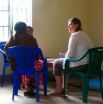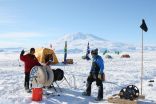(Press-News.org) EVANSTON, Ill. --- Do we think of nature as something that we enjoy when we visit a national park and something we need to "preserve?" Or do we think of ourselves as a part of nature? A bird's nest is a part of nature, but what about a house?
The answers to these questions reflect different cultural orientations. They are also reflected in our actions, our speech and in cultural artifacts.
A new Northwestern University study, in partnership with the University of Washington, the American Indian Center of Chicago and the Menominee tribe of Wisconsin, focuses on science communication and how that discipline necessarily involves language and other media-related artifacts such as illustrations. The challenge is to identify effective ways of communicating information to culturally diverse groups in a way that avoids cultural polarization, say the authors.
"We suggest that trying to present science in a culturally neutral way is like trying to paint a picture without taking a perspective," said Douglas Medin, lead author of the study and professor of psychology in the Weinberg College of Arts and Sciences and the School of Education and Social Policy at Northwestern.
This research builds on the broader research on cultural differences in the understanding of and engagement with science.
"We argue that science communication -- for example, words, photographs and illustrations -- necessarily makes use of artifacts, both physical and conceptual, and these artifacts commonly reflect the cultural orientations and assumptions of their creators," write the authors.
"These cultural artifacts both reflect and reinforce ways of seeing the world and are correlated with cultural differences in ways of thinking about nature. Therefore, science communication must pay attention to culture and the corresponding different ways of looking at the world."
Medin said their previous work reveals that Native Americans traditionally see themselves as a part of nature and tend to focus on ecological relationships. In contrast, European-Americans tend to see humans as apart from nature and focus more on taxonomic relationships.
"We show that these cultural differences are also reflected in media, such as children's picture books," said Medin, who co-authored the study with Megan Bang of the University of Washington. "Books authored and illustrated by Native Americans are more likely to have illustrations of scenes that are close-up, and the text is more likely to mention the plants, trees and other geographic features and relationships that are present compared with popular children's books not done by Native Americans.
"The European-American cultural assumption that humans are not part of ecosystems is readily apparent in illustrations," he said.
The authors went to Google images and entered "ecosystems," and 98 percent of the images did not have humans present. A fair number of the remaining 2 percent had children outside the ecosystem, observing it through a magnifying glass and saying, "I spy an ecosystem."
"These results suggest that formal and informal science communications are not culturally neutral but rather embody particular cultural assumptions that exclude people from nature," Medin said.
Medin and his research team have developed a series of "urban ecology" programs at the American Indian Center of Chicago, and these programs suggest that children can learn about the rest of nature in urban settings and come to see humans as active players in the world ecosystems.
INFORMATION:
MEDIA CONTACT: Hilary Hurd Anyaso at 847-491-4887 or h-anyaso@northwestern.edu
"The Cultural Side of Science Communication" was published in the Proceedings of the National Academy Sciences.
NORTHWESTERN NEWS: http://www.northwestern.edu/newscenter/
The cultural side of science communication
New research explores how culture affects our conceptions of nature
2014-09-30
ELSE PRESS RELEASES FROM THIS DATE:
Rating the planet's oceans
2014-09-30
The most comprehensive assessment conducted by the Ocean Health Index rates the Earth's oceans at 67 out of 100 in overall health. In addition, for the first time, the report assessed the Antarctic and the 15 ocean regions beyond national jurisdiction (high-seas areas) — all critical regions for maintaining a healthy climate, safeguarding biodiversity and providing sustainable food sources.
In the third annual update of the index, a partnership led by scientists from UC Santa Barbara's National Center for Ecological Analysis and Synthesis (NCEAS) and Conservation International ...
New diagnostic approach for autism in Tanzania
2014-09-30
PROVIDENCE, R.I. [Brown University] — Autism is no stranger to the children of Tanzania. What is rare in the East African nation is access to clinical services, including reliable diagnosis and evidence-based treatments. There is no autism diagnostic measure, for example, validated for use in Swahili, a major language of the region. In a small new study, however, researchers at Brown University and the University of Georgia (UGA) describe a culturally compatible diagnostic approach that they implemented at two sites in the country and found to be effective for making diagnoses.
The ...
This week from AGU: Measuring Antarctic ice loss, Indian Ocean program, Oregon landslides
2014-09-30
This week from AGU: Measuring Antarctic ice loss, Indian Ocean program, Oregon landslides
From AGU's blogs: Scientists use fiber-optic cables to measure ice loss in Antarctic
Researchers installed moorings containing fiber-optic cables hundreds of meters down into the McMurdo Ice Shelf in West Antarctica to collect temperature information about the base of the ice shelf, where the thick platform of floating ice meets the ocean. The sensors were able to measure mere millimeters of ice loss at the interface, demonstrating that the new fiber-optic method could be ...
Depression increasing across the country
2014-09-30
SAN DIEGO, Calif. (Sept. 30, 2014)— A study by San Diego State University psychology professor Jean M. Twenge shows Americans are more depressed now than they have been in decades.
Analyzing data from 6.9 million adolescents and adults from all over the country, Twenge found that Americans now report more psychosomatic symptoms of depression, such as trouble sleeping and trouble concentrating, than their counterparts in the 1980s.
"Previous studies found that more people have been treated for depression in recent years, but that could be due to more awareness and less ...
Disease decoded: Gene mutation may lead to development of new cancer drugs
2014-09-30
ANN ARBOR—The discovery of a gene mutation that causes a rare premature aging disease could lead to the development of drugs that block the rapid, unstoppable cell division that makes cancer so deadly.
Scientists at the University of Michigan and the U-M Health System recently discovered a protein mutation that causes the devastating disease dyskeratosis congenita, in which precious hematopoietic stem cells can't regenerate and make new blood. People with DC age prematurely and are prone to cancer and bone marrow failure.
But the study findings reach far beyond the ...
New guidelines for treatment of hypothyroidism endorse current therapy
2014-09-30
WASHINGTON (Sept. 30, 2014) — Levothyroxine is considered the gold standard therapy for an underactive thyroid gland (hypothyroidism), and a new review of therapies for the condition — including combining levothyroxine with another agent — has not altered that assessment, say a team of investigators.
1Their analysis, published as a set of guidelines in the journal Thyroid, finds insufficient consistent data exist to recommend a change in use of levothyroxine — whether generic, or sold under various trade names, such as Synthroid® — as the only drug needed to treat hypothyroidism.
"Levothyroxine ...
A new dimension for integrated circuits: 3-D nanomagnetic logic
2014-09-30
This news release is available in German.
Electrical engineers at the Technische Universität München (TUM) have demonstrated a new kind of building block for digital integrated circuits. Their experiments show that future computer chips could be based on three-dimensional arrangements of nanometer-scale magnets instead of transistors. As the main enabling technology of the semiconductor industry – CMOS fabrication of silicon chips – approaches fundamental limits, the TUM researchers and collaborators at the University of Notre Dame are exploring "magnetic computing" ...
Medicaid and Uninsured patients obtain new patient appointments most easily at FQHCs
2014-09-30
PHILADELPHIA – Federally Qualified Health Centers (FQHCs) granted new patient appointments to Medicaid beneficiaries and uninsured patients at higher rates than other primary care practices (non-FQHCs), in addition to charging less for visits, according to results of a new 10-state University of Pennsylvania study published this month in Medical Care.
Using data from a previous "secret shopper" study conducted in 2012 and 2013, the investigators found that FQHCs — community health clinics that receive federal funding to provide primary care access to underserved populations ...
UCI study uncovers important process for immune system development
2014-09-30
Irvine, Calif., Sept. 30, 2014 — Research by UC Irvine immunologists reveals new information about how our immune system functions, shedding light on a vital process that determines how the body's ability to fight infection develops.
In the online version of Nature Immunology, neurology professor Dr. Michael Demetriou, postdoctoral scholar Raymond Zhou and other Institute for Immunology colleagues describe a critical mechanism underlying how T cells are created, selected and released into the bloodstream.
A T cell is a type of blood cell called a lymphocyte that protects ...
Expect 6,000 more Australian deaths if pollution rises to 'safe' threshold
2014-09-30
The National Environment Protection Measures (NEPM) has set maximum daily limits, or 'standards', for six key outdoor pollutants, which QUT's Associate Professor Adrian Barnett says many authorities wrongly assume to be 'safe' thresholds for health.
To test that assumption, Professor Barnett calculated what the health effects would be if the current average levels of five of those pollutants across Melbourne, Sydney and Brisbane were to rise to just below the NEPM 'safe' standards.
"I've found that increasing pollution levels to just below the NEPM standards would cause ...
LAST 30 PRESS RELEASES:
Numbers in our sights affect how we perceive space
SIMJ announces global collaborative book project in commemoration of its 75th anniversary
Air pollution exposure and birth weight
Obstructive sleep apnea risk and mental health conditions among older adults
How talking slows eye movements behind the wheel
The Ceramic Society of Japan’s Oxoate Ceramics Research Association launches new international book project
Heart-brain connection: international study reveals the role of the vagus nerve in keeping the heart young
Researchers identify Rb1 as a predictive biomarker for a new therapeutic strategy in some breast cancers
Survey reveals ethical gaps slowing AI adoption in pediatric surgery
Stimulant ADHD medications work differently than thought
AI overestimates how smart people are, according to HSE economists
HSE researchers create genome-wide map of quadruplexes
Scientists boost cell "powerhouses" to burn more calories
Automatic label checking: The missing step in making reliable medical AI
Low daily alcohol intake linked to 50% heightened mouth cancer risk in India
American Meteorological Society announces Rick Spinrad as 2026 President-Elect
Biomass-based carbon capture spotlighted in newly released global climate webinar recording
Illuminating invisible nano pollutants: advanced bioimaging tracks the full journey of emerging nanoscale contaminants in living systems
How does age affect recovery from spinal cord injury?
Novel AI tool offers prognosis for patients with head and neck cancer
Fathers’ microplastic exposure tied to their children’s metabolic problems
Research validates laboratory model for studying high-grade serous ovarian cancer
SIR 2026 delivers transformative breakthroughs in minimally invasive medicine to improve patient care
Stem Cell Reports most downloaded papers of 2025 highlight the breadth and impact of stem cell research
Oxford-led study estimates NHS spends around 3% of its primary and secondary care budget on the health impacts of heat and cold in England
A researcher’s long quest leads to a smart composite breakthrough
Urban wild bees act as “microbial sensors” of city health.
New study finds where you live affects recovery after a hip fracture
Forecasting the impact of fully automated vehicle adoption on US road traffic injuries
Alcohol-related hospitalizations from 2016 to 2022
[Press-News.org] The cultural side of science communicationNew research explores how culture affects our conceptions of nature



